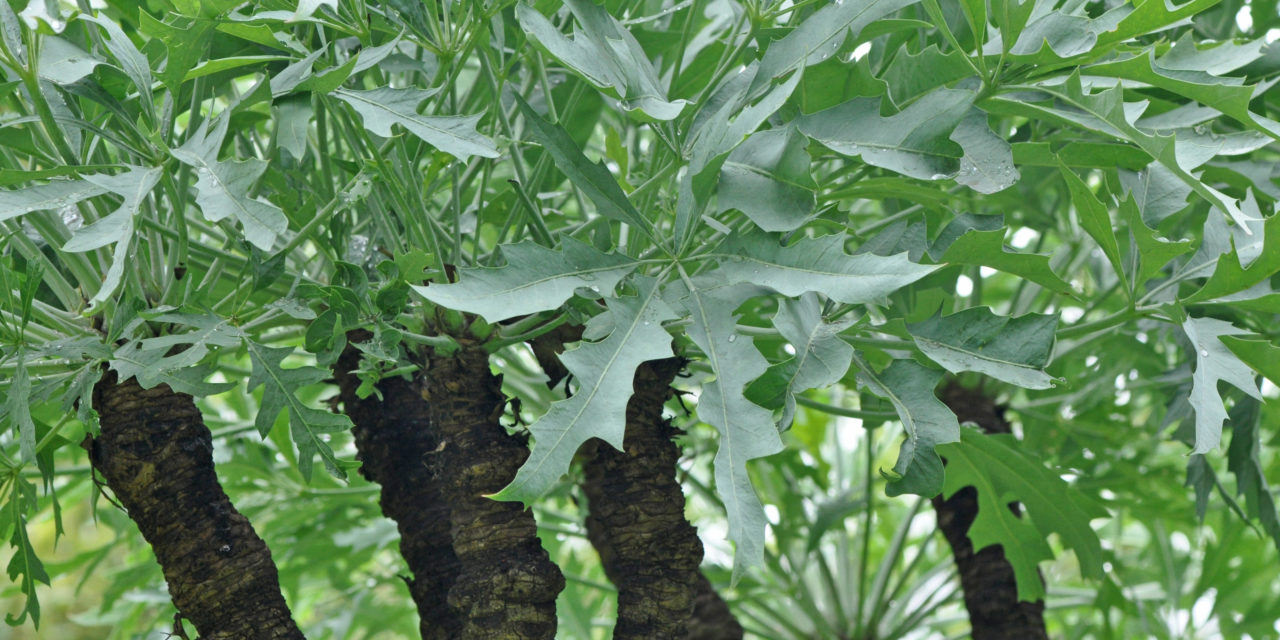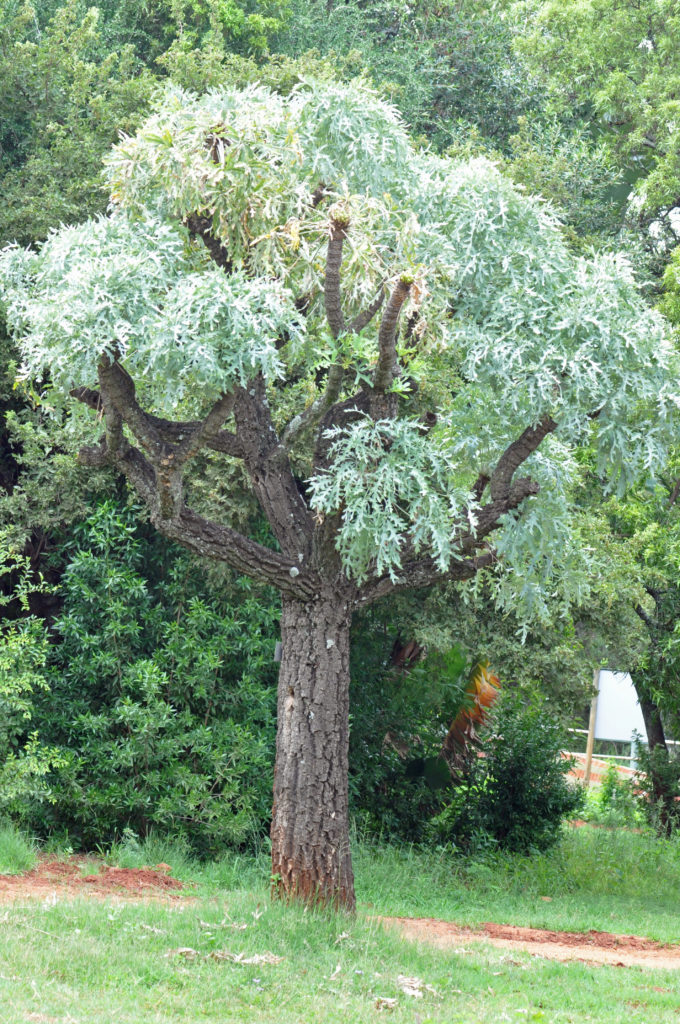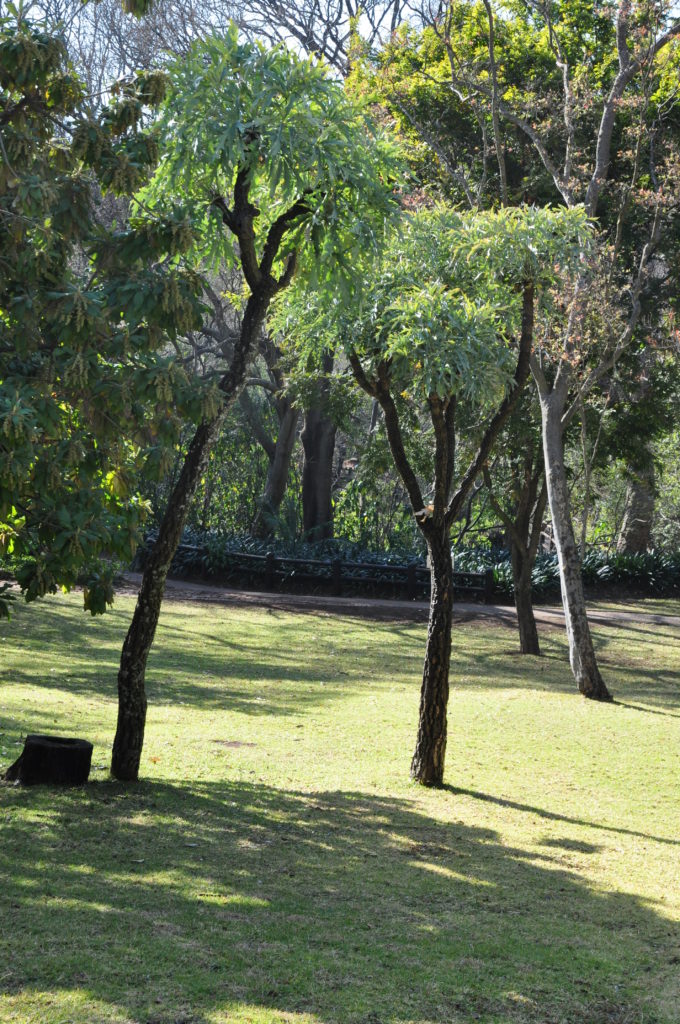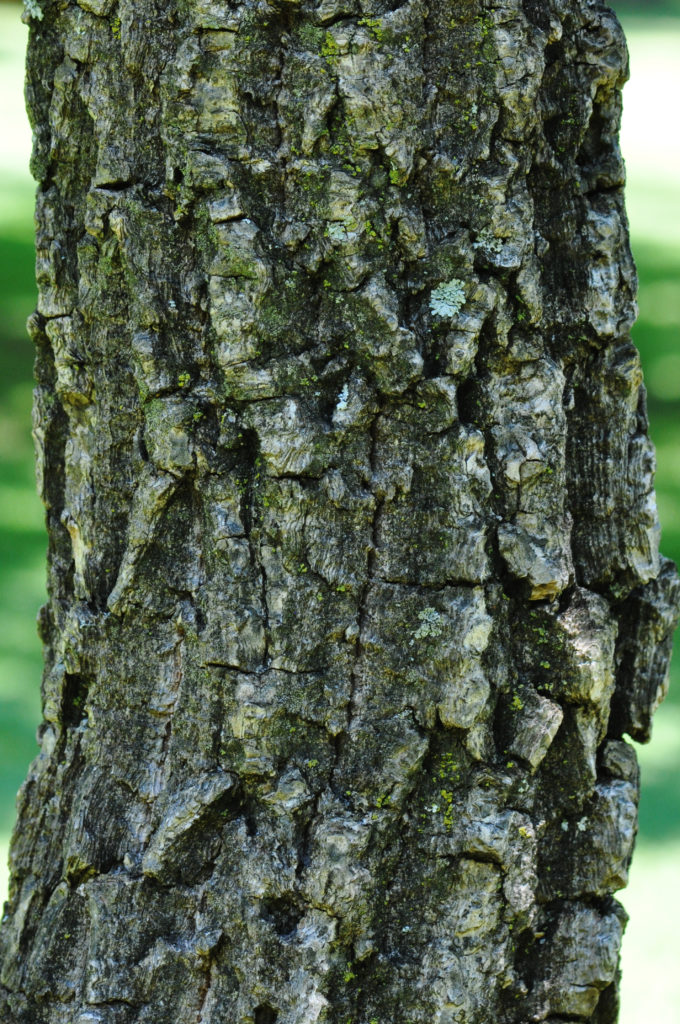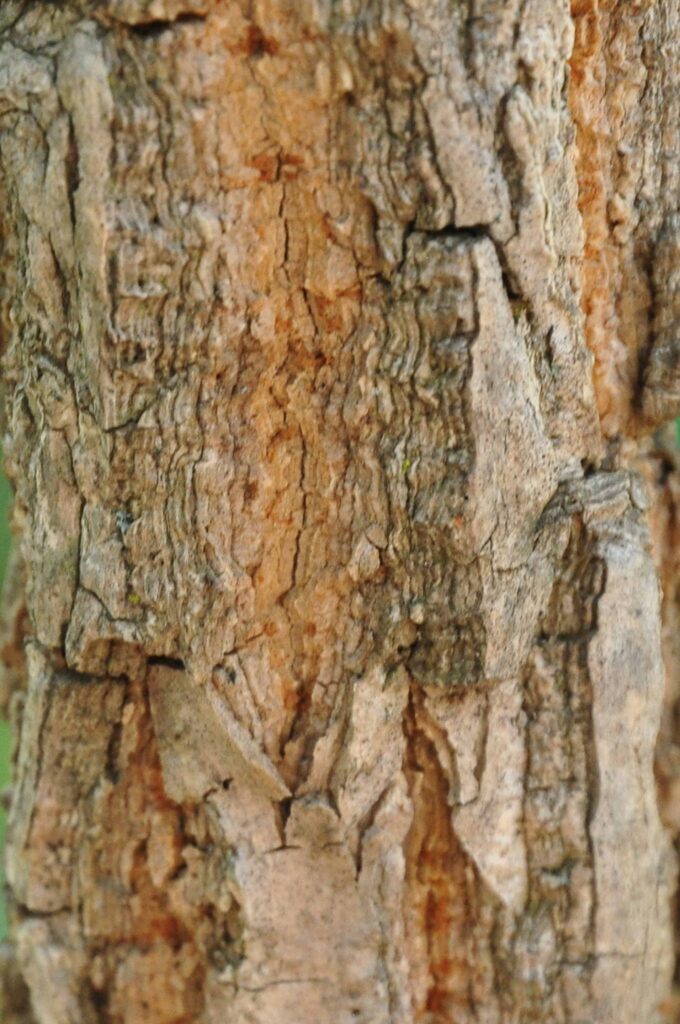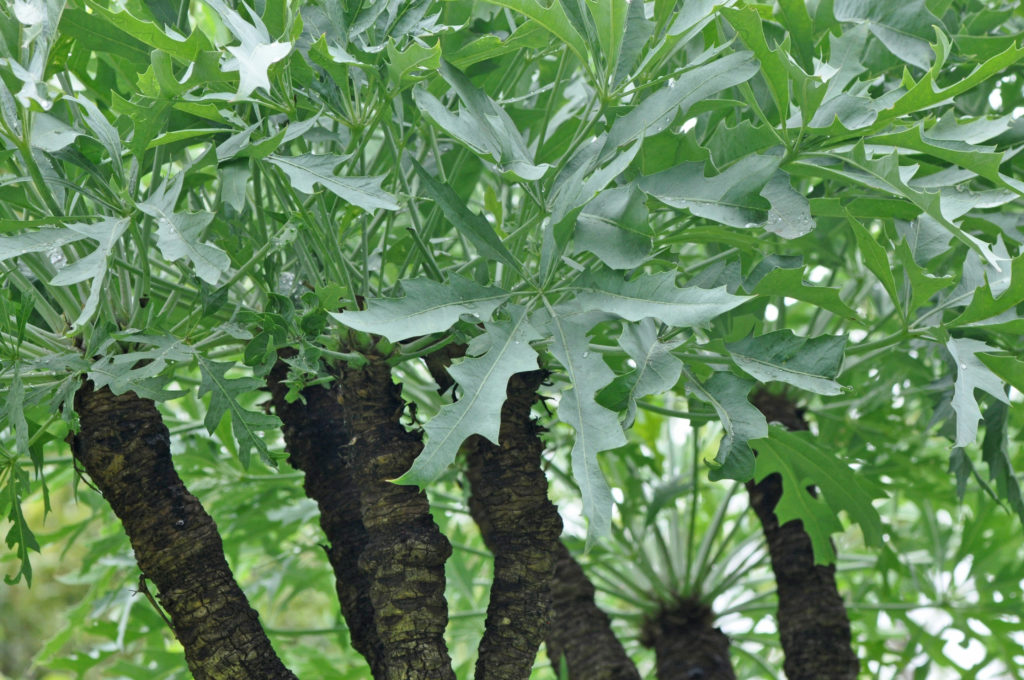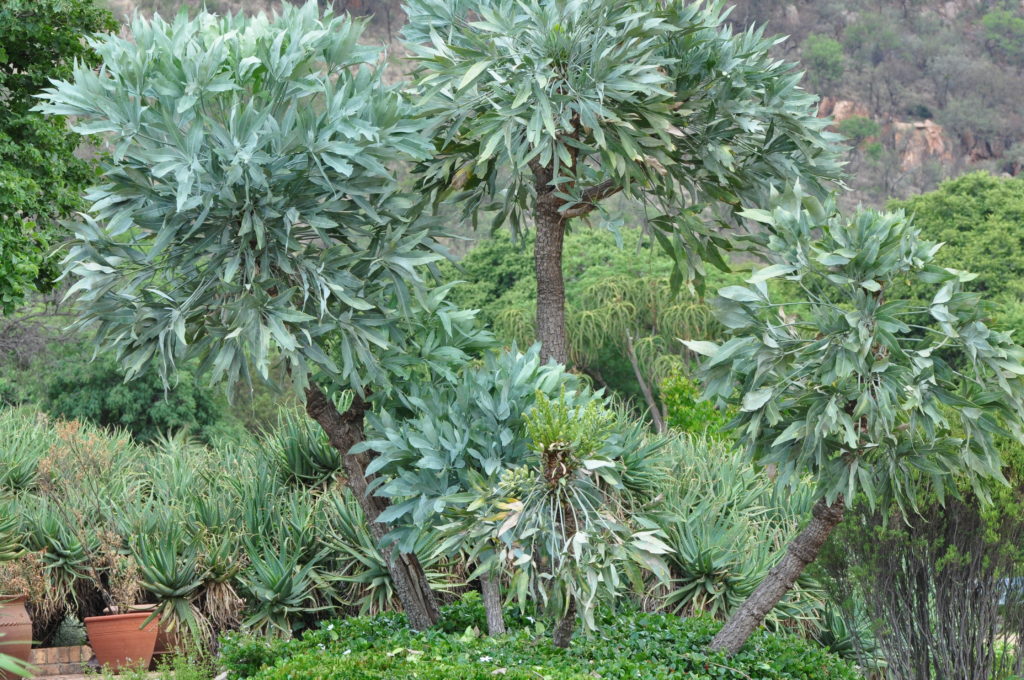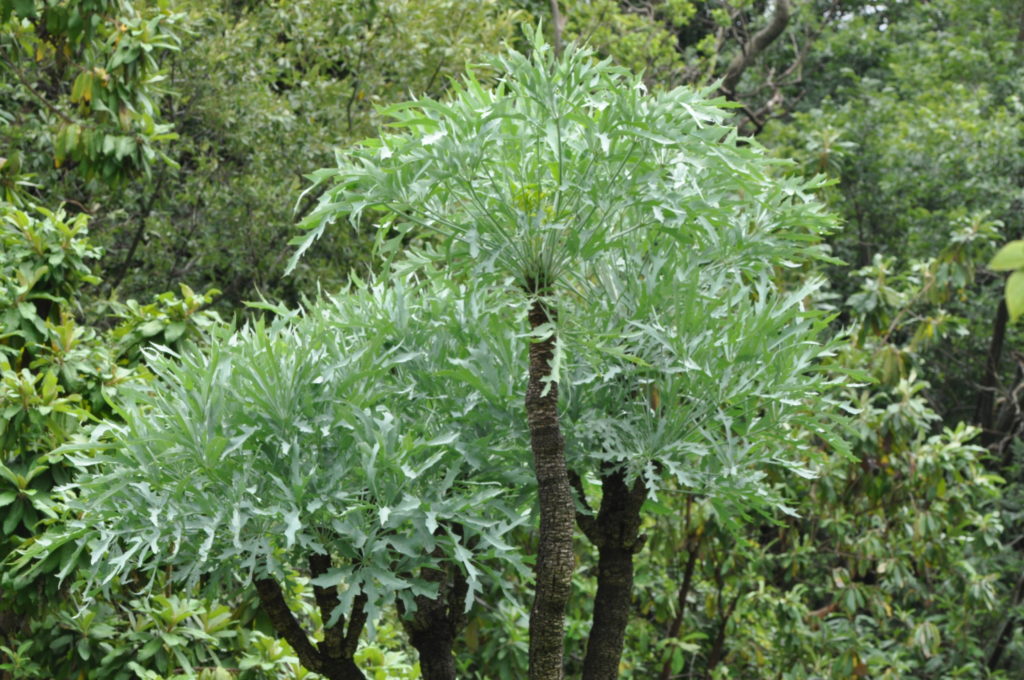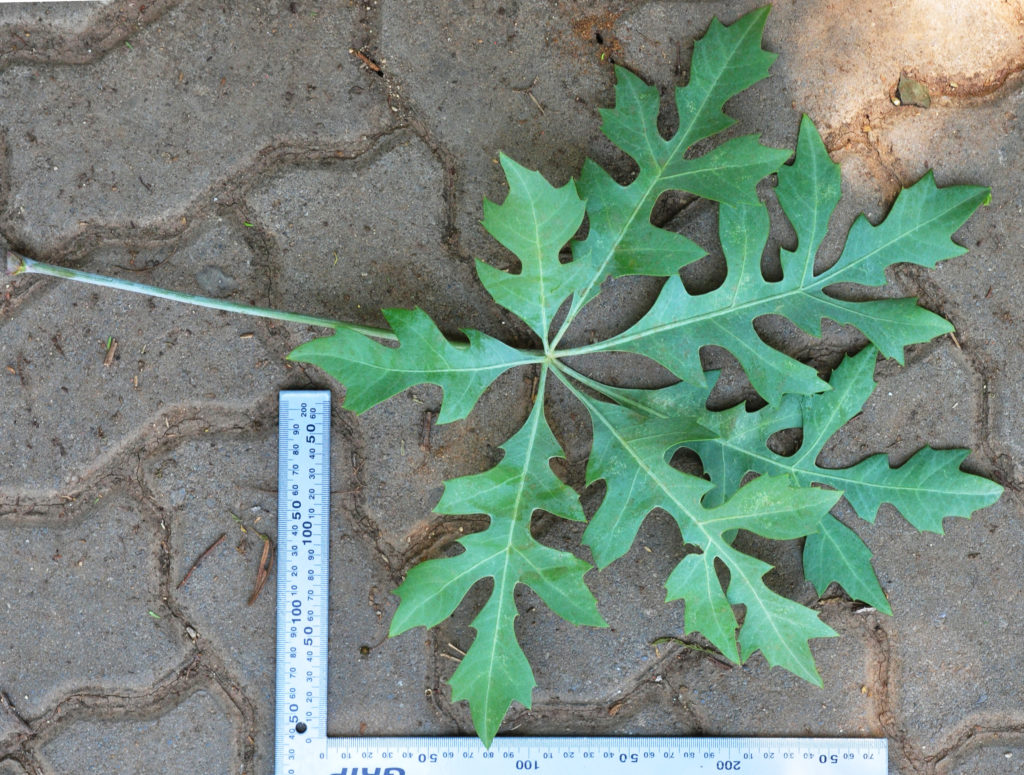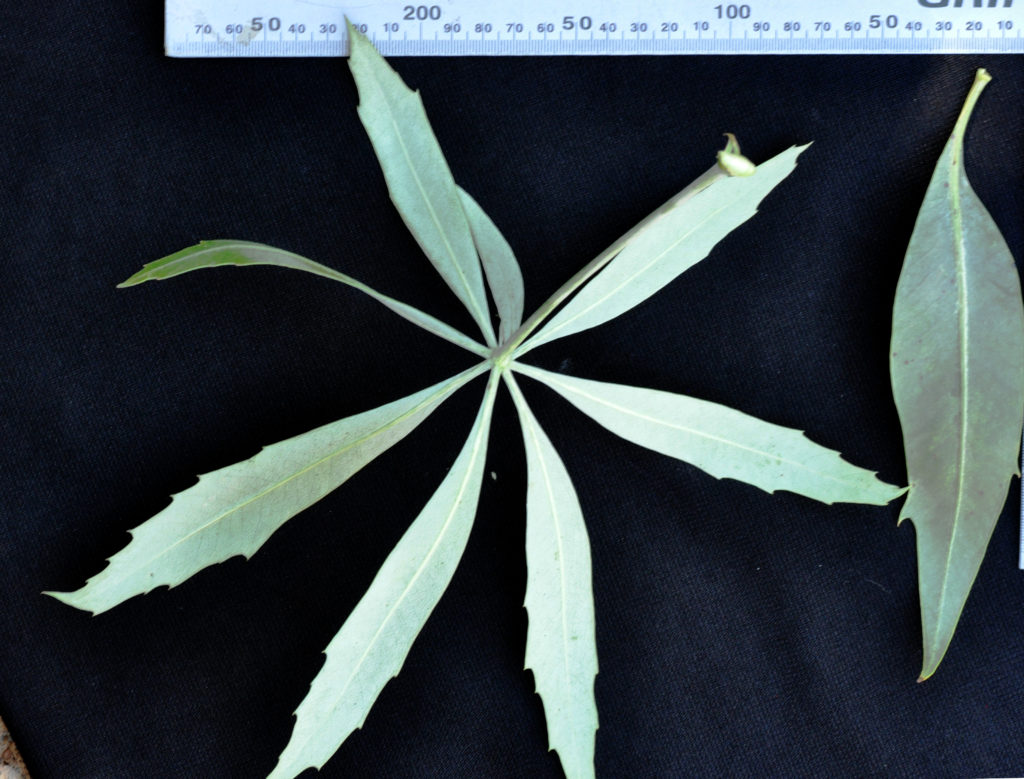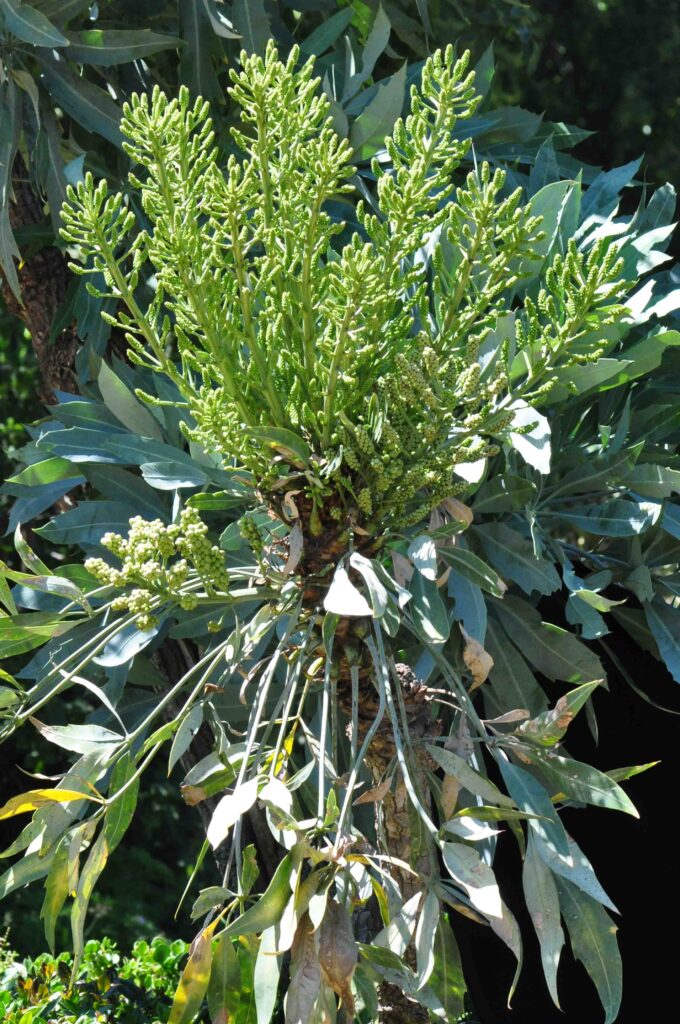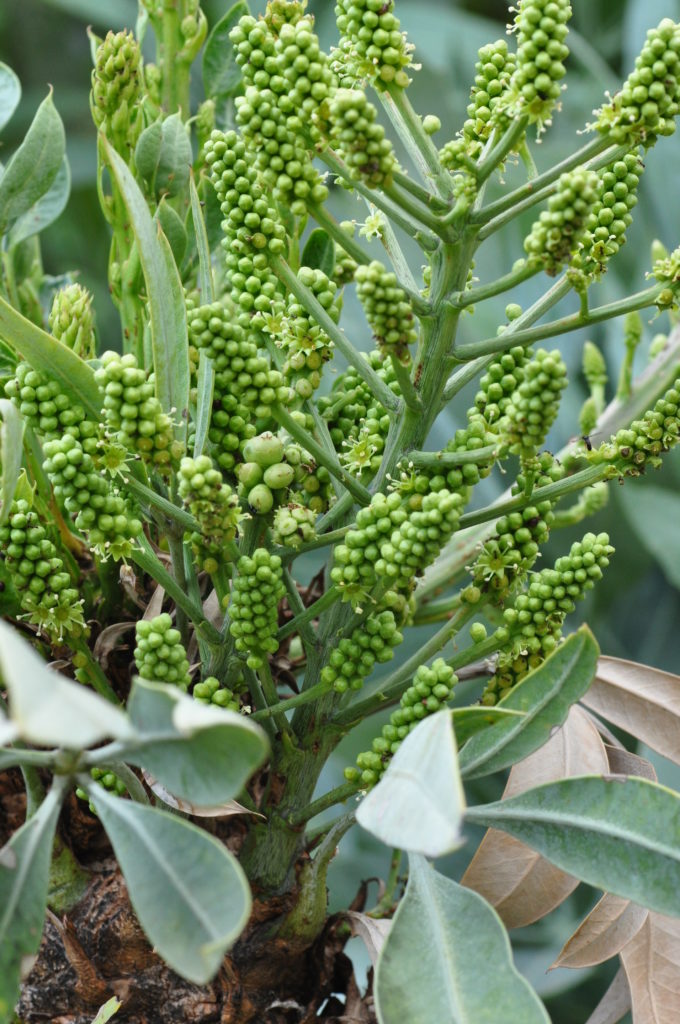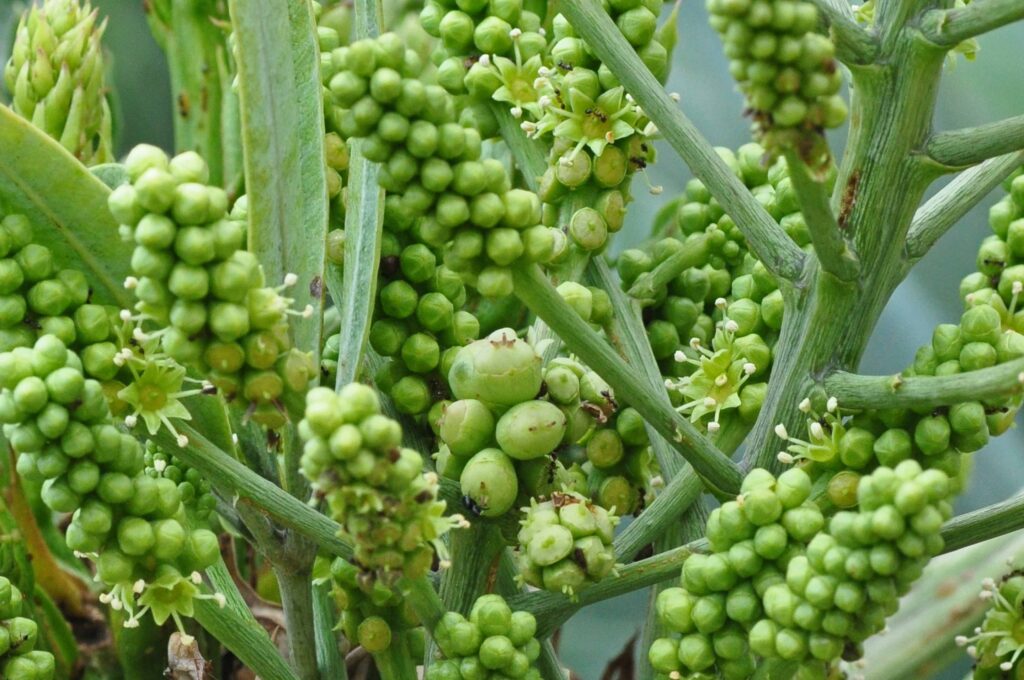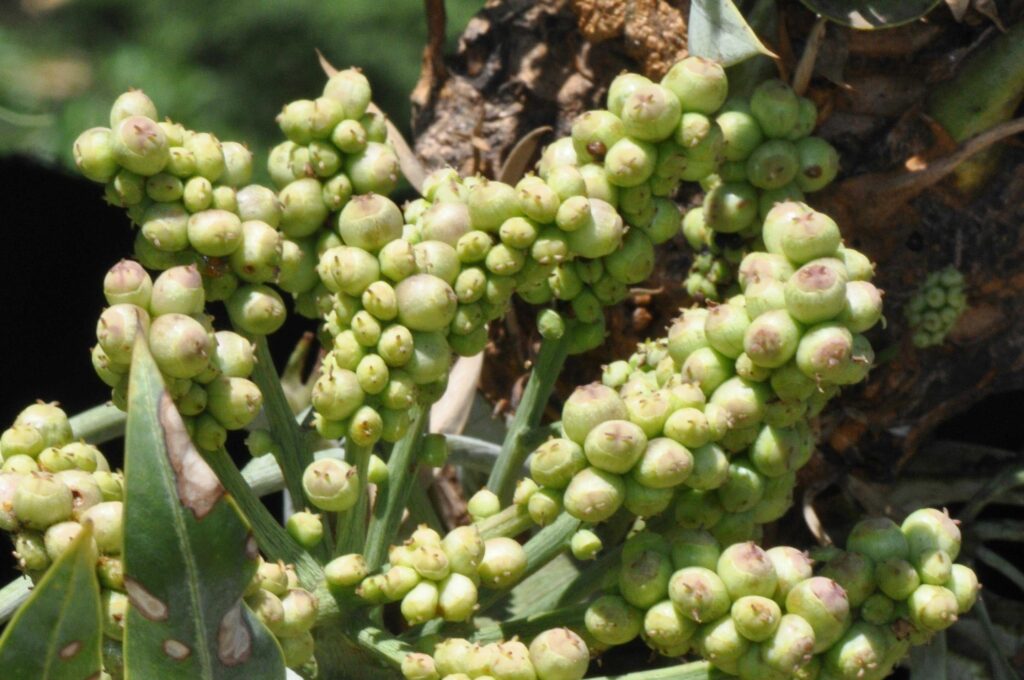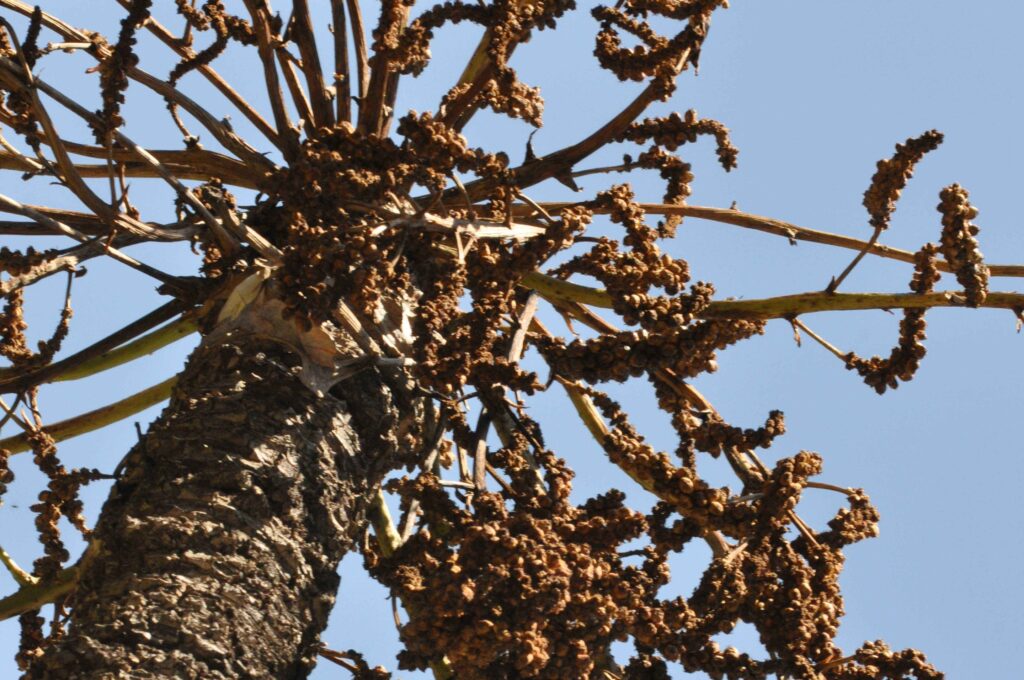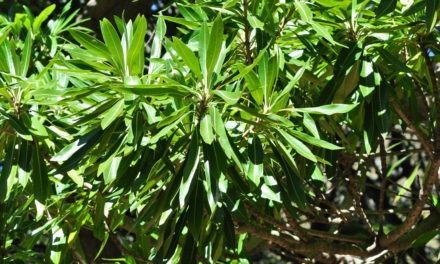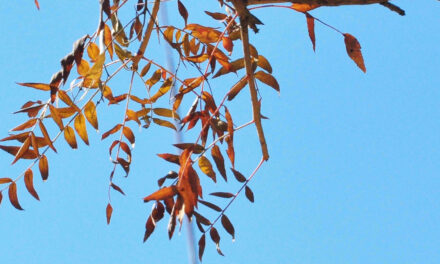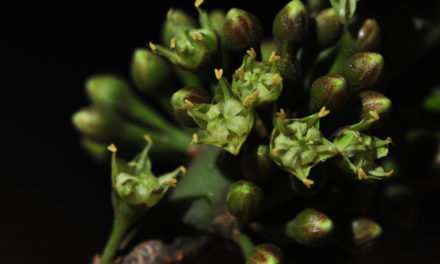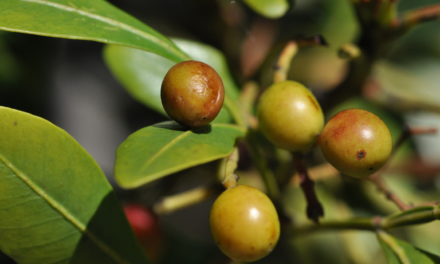General Info – summary
This short, pachycaul plant is a little branched Tree up to 6m high and develops a rough trunk up to 0,6m wide. Bark becomes longitudinally fissured. Long palmately, once compound leathery and glabrous Leaves occur at branch ends & have a long petiole. Leaflets are up to 30 x 6cm. Small, 5-merous, bisexual, regular & insect pollinated Flowers are in spikes. The small, fleshy & globose Fruit produces black seeds.
Description
Cussonia paniculata
SA Tree No. 563 (Cussonia paniculata subsp. paniculata). Previous Name: Cussonia paniculata var. paniculate. Common names: (Afr) Bergkiepersol, Hoeveldkiepersol. (Eng) Mountain Cabbage-tree.
SA Tree No. 563.1 (Cussonia paniculata subsp. sinuata) Previous Name: Cussonia paniculata var. sinuate. Common names: (Afr) Karookiepersol. (Eng) Cabbage Tree.
Family Araliaceae: (Ivy and cabbage-tree family). The family includes trees, shrubs, vines and herbs. The mainly woody species are of tropical distribution. In southern Africa, there are 5 genera and about 18 species. Those genera with trees on this website include Cussonia and Schefflera. Leaves are usually alternate. They may also be once or twice digitally compound. 1-3 bracts that persist around the fruit and subtend the regular, bisexual or unisexual Flowers. In Cussonia the flowers are in spikes or racemes and in Schefflera flowers are umbels, in panicles. The Calyx is often reduced. There are usually as many Stamens as Petals. Anthers are ovate or oblong with 2 pollen sacs. The usually 5 petals are attached to the inferior, 2-locular Ovary. Each locule has a single ovule. Styles equal the number of locules. The often-fleshy Fruit is usually a drupe or berry. It may split into individual carpel units, called mericarps, with 1 or more seeds.
Family: Fabaceae, or Leguminosae (Pea, bean or legume family). After the Orchidaceae and the Asteraceae, the Fabaceae is the third largest Angiosperm (flowering plants) family with 700+ genera and close to 20 000 species. Local Tree genera on this website include Acacia (Vauchellia, Senegalia), Albizia, Bauhinia, Bolusanthus, Burkea, Calpurnia, Colophospermum, Cordyla, Cyclopia, Dichrostachys, Erythrina, Erythrophleum, Faidherbia, Indigofera, Mundulea, Peltophorum, Philenoptera, Piliostigma, Schotia and Xanthocercis. The Fabaceae are recognisable by their fruit and their pinnately compound Leaves. Leaves may also be simple – even bilobed and usually have stipules – some of which may be spinescent. Leaflets are usually entire. Flowers are bisexual and bracteate. Regular flowers usually have 4-5 sepals and the same number of petals. Irregular flowers have 4-5 sepals and 5 or less petals. Stamens have anthers that have 2 pollen sacs and there are usually at least twice the number of stamens as petals – often 10. The superior Ovary has 1 locule containing 1 or more ovules. The Stigma and Style are simple. The single carpel develops into the Fruit, which is usually a pod. The mature pods may dehisce or break into segments. Seeds vary.
Name derivation: Cussonia. The name Cussonia was given by Carl Peter Thunberg to commemorate the French botanist Pierre Cusson (1727-1783). He was professor of Botany at the University of Montpellier in France. He specialised in the Apiaceae or Umbellifera. subsp paniculata – panicle – branched inflorescence with stalked flowers. subsp sinuata – with wavy margins. There are about 25 species of the genus Cussonia. About 8 species of Cussonia occur in the southern Africa. Cussonia sp. also occur in Madagascar and the Comoros Islands.
Conservation: National Status: L C. (Least Concern). Assessed: 2005 (W. Foden and L. Potter).
Tree
This short, thickset, often little-branched Tree, with a rounded crown (photo 333) is usually up to 5m high. The few younger Branches (photo 252) have prominent leaf scars. The thick, corky Trunk has a diameter of up to 0,6m (photo 252). This plant is pachycaul (has a disproportionately thick trunk for its height) but thinner in the forest (photo 333). Bark is rough, grey-brown to black and becomes longitudinally fissured (photos 12 and 549). The Roots are thick and swollen.
- 252. 2016/01/26 Pretoria NBG. Photo: David Becking.
- 333. 2014/12/09 Walter Sisulu NBG. Photo: David Becking.
- 12. 2014/11/25 Walter Sisulu NBG. Photo: David Becking.
- 549. 2014/10/28 Walter Sisulu NBG. Photo: David Becking.
Leaves.
These trees are only deciduous in cold areas. The Leaves are an impressive pale blue-green to green, and up to 60cm wide. Each leaf is glabrous (hairless) with a thick protective waxy covering. Apart from protecting the leaf, this enhances the overall tree appearance. Leaves are concentrated at the ends of branches where they appear mop-like (photo 552 & photo 252 under Tree). The younger leaves are a lighter green (Sep-Oct). The leaves are Palmate (compound leaves that are lobed, divided or ribbed in a palm-like or hand-like fashion with leaflets arising from a single point – photos 546 & 21). New leaves emerge in spring and are a brighter green. Each mature leaf has up to 13 leaflets but usually from 7 to 9. The leaflets may have incisions, but these are not sufficient to divide the leaflets into more leaflets. The leathery leaflets are up to 30 x 6cm. Leaflet Margins may be wavy, and leaflets are either without lobes (Cussonia paniculata subsp. paniculate) or on a larger, wider spreading tree, with deeply lobed leaflets (Cussonia paniculata subsp. sinuata). These constrictions do not reach the midrib i.e., they do not make separate leaflets as in Cussonia spicata). The attenuate (showing a long gradual taper) Apex tapers to a sharp tip and the Base tapers. The long Petiole (leaf stalk) is up to 50cm in length. It is slender with a wide base. Petiolules (stalks of leaflets – photo 546) are up to 3cm long. Stipules (basal appendages of the petiole) are present.
- 553. 2014.12.09 Walter Sisulu NBG. Photo: David Becking.
- 63. 2015/10/27. Walter Sisulu NBG. Photo: David Becking.
- 552. 2014/12/09. Walter Sisulu NBG. Photo: David Becking.
- 546. 2014/10/28. Walter Sisulu NBG. Photo: David Becking.
- 21. 2015/11/24. Walter Sisulu NBG. Photo: David Becking.
Flowers
The small (about 6mm in diameter), greenish yellow Flowers are located in dense (8-30) cylindrical raceme-like Spikes (simple indeterminate inflorescence with sessile flowers on a single unbranched stalk – photo 644). Each flower is up to 6mm wide and each flowers spike is up to 12cm long. The spikes are themselves gathered in groups of round panicles (much-branched inflorescence photo 664). The spike peduncle (stalk of flower cluster) is long. In subsp. paniculate, the primary inflorescence branches are spiralled along an elongated axis, and in subsp. sinuata they arise close to the same point. The Calyx has 5 toothed or almost entire Sepals. There are 5 Petals present in each flower (photo 664E). In the bud, their edges meet but do not overlap. The 5 Stamens (photo 664E) each have Anthers with 2 Thecae (pollen sacs) that produce a large amount of pollen. These anthers are shorter than their Filaments. There is a single Pistil (a unit of the Gynoecium, the female element of the flower). It is composed of a 2-locular, inferior Ovary that has 2 Locules and 2 Styles each ending in a Stigma. The large amount of nectar produced attracts many flying Insects to the flowers and they are responsible for pollination. (Jan-Apr).
- 30. 2015/11/24. Walter Sisulu NBG. Photo: David Becking.
- 664. 2015/10/27. Walter Sisulu NBG. Photo: David Becking.
- 664E. 2015/10/27. Walter Sisulu NBG. Photo: David Becking.
Fruit
The fleshy Fruit is globose (spherical or nearly so), up to 6mm wide and closely crowded in spikes (photos below). There are 2 Carpels (each carpel is one of the foliar units of a compound pistil or ovary). The Fruit turns from green to purple or maroon when mature. The ripe Seeds are black. (Apr-Aug).
- 27. 2015/11/24. Walter Sisulu NBG. Photo: David Becking.
- 815. 2016/08/30. Walter Sisulu NBG. Photo: David Becking.
Distribution & Ecology
In Cussonia paniculata subsp. paniculata) the leaflets are entire or the end part may be serrated. This smaller subsp. has limited distribution in the southern mountain ranges of Western Cape, Eastern Cape and Northern Cape. Here the conditions are rather dry, with greater temperature and rain variation. The primary inflorescence branches are spiralled along an elongated axis. In Cussonia paniculata subsp. sinuata) the leaflets are coarsely lacy, and these plants occur in Free State, Gauteng, Western KwaZulu-Natal and northwards to include Limpopo, Mpumalanga, North West, Eswatini (Swaziland) and Botswana. In subsp. sinuata the primary inflorescence branches usually arise from the same point. Both of these subsp. are mainly inland plants and do not normally occur at the coast. A thick protective waxy covering occurs on the Leaves. This together with the swollen and widespread Roots help the plant in dry times. Apart from the Western Cape, these trees are located in all provinces of South Africa. Larvae of the Cabbage-tree emperor Moth (Bunaea alcinoe – photo 555) – feed on these tree leaves and on other plants such as Celtis, Ekebergia capensis, Croton and Bauhinia. Locusts can defoliate a tree. Fruit flies are frequent visitors, and their larvae may occur below the bark. These plants attract birds, butterflies and moths.
- 555. 2017/01/24 Walter Sisulu NBG. Photo: D Becking.
Ethnobotany
The soft, whitish Wood was once used for making brake pads for wagons. Leaves are good fodder for domestic herbivores – especially goats. The Plant is frost and drought resistant but not very fast growing. Seedlings are reported to provide aseptic material for use in micro-propagation. Local medicine makes use of extracts from this tree. This slow growing plant is a good garden prospect and can be grown from seeds, extracted from freshly ripened fruit. Plant trees in a sunny, well-drained site – preferably on a slope and away from buildings and paving. This is because of the aggressive Roots. The roots are edible and a source of moisture in times of need. Cussonia paniculata subsp. sinuata is usually the plant found most attractive for gardens.
References
Boon, R. 2010. Pooley’s Trees of eastern South Africa. Flora and Fauna Publications Trust, Durban.
Coates Palgrave, M. 2002. Keith Coates Palgrave Trees of Southern Africa, edn 3. Struik, Cape Town.
Foden, W. & Potter, L. 2005. Cussonia paniculata Eckl. & Zeyh. subsp. sinuata (Reyneke & Kok) De Winter. National Assessment: Red List of South African Plants version 2020.1. Accessed on 2023/02/04.
Foden, W. & Potter, L. 2005. Cussonia paniculata Eckl. & Zeyh. subsp. paniculata. National Assessment: Red List of South African Plants version 2020.1. Accessed on 2023/02/03.
Lawrence, G. H. M, 1951. Taxonomy of Vascular Plants, The Macmillan Company, New York. Tenth Printing 1965.
Palmer, E. & Pitman, N. 1972. Trees of southern Africa, Balkema, Amsterdam, Cape Town.
Schmidt, S. Lotter, M. & McCleland, W. 2002. Trees and Shrubs of Mpumalanga and the Kruger National Park.
van Wyk, B. & van Wyk, P. 1997 Field guide to Trees of Southern Africa, Struik, Cape Town.
http://operationwildflower.org.za/index.php/plant-records/trees/166-cussonia-paniculata
http://www.plantzafrica.com/plantcd/cussoniapan.htm
http://posa.sanbi.org/flora/browse.php?src=SP

